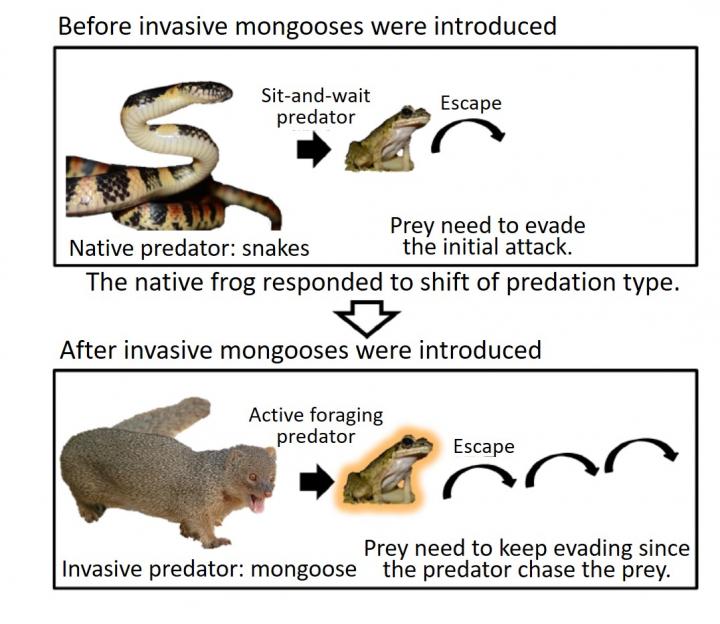Invasive mongooses altered leg length and endurance of endangered island frogs

Credit: Hirotaka Komine/ TUAT
Biodiversity is increasingly ruined by humanity’s many impacts, a major aspect of which is biological invasion. Although there are a lot of studies reporting that invasive predators decrease the population size of native species, only a few studies have reported impact on phenotypic traits such as morphology and performance of native species. Particularly island ecosystem is very sensitive to invasive predators because strong predators such as mammalian predators are not in such environment.
Researchers at Tokyo University of Agriculture and Technology (TUAT) analyzed predators’ effect on frogs in a Japanese island and their findings were reported in Biological Invasions on January 3rd.
Mongooses were introduced many areas worldwide and damaged native ecosystem seriously. In 1979, these were brought to Amami Island in Japan. As a result, Amami tip-nosed frog, which is a relatively large forest species, is one of the species at risk of extinction in near future due to the invasive mongoose.
“We hypothesized the strong predation pressure of mongoose drove rapid change in morphology and performance of the native frog,” said Hirotaka Komine, first author of the paper, assistant professor (when this research was done) at TUAT.
“We recorded hind limb length and two types of performance traits: burst movement ability (evaluated based on jump distance) and endurance (evaluated based on number of jumps), ” said Komine. For jump distance, the researchers measured the distance of the first jump after the frog was released. For the number of jumps, they analysed the number of jumps in the net upon capture until the frog was exhausted (i.e., stopped jumping). “We then estimated the relationship between hind limb length and explanatory variables (proxy of mongoose impact, sex, year), and the relationship between performance traits and the explanatory variables using a spatial regression model, ” Komine explains.
Interestingly, the results showed that the hind limb length of the frog was longer under the strong predation effect of the mongoose, which may have acted as a selective agent to induce rapid morphological responses. The endurance, but not the burst movement ability, of the frog was higher under the strong effect of predation by the mongoose. “Our results suggest that endurance was a specific target of natural selection and that the performance of the native prey changed in response to the new predation type,” said Komine.
When their research was carried out it was at least 7 years after the mongooses were mostly removed and population size of the native frog recovered owing to the eradication project run by the Ministry of the Environment of Japan. Therefore, apparently their result suggested that impact of invasive mongooses on phenotypic traits of native frog remained even after the invasive predator mostly removed.
“Island ecosystem is often unique in terms of behavior, morphology, and performance, reflecting its evolutionary uniqueness. Hence, the recovery of traits in native species after the removal of invasive species may be a useful measure of the success of eradication projects,” concludes Komine.
###
More information about Dr Komine, please visit https:/
About Tokyo University of Agriculture and Technology (TUAT):
TUAT is a distinguished university in Japan dedicated to science and technology. TUAT focuses on agriculture and engineering that form the foundation of industry, and promotes education and research fields that incorporate them. Boasting a history of over 140 years since our founding in 1874, TUAT continues to boldly take on new challenges and steadily promote fields. With high ethics, TUAT fulfills social responsibility in the capacity of transmitting science and technology information towards the construction of a sustainable society where both human beings and nature can thrive in a symbiotic relationship. For more information, please visit http://www.
Original publication:
Komine, H. *, Iwai, N. & Kaji, K. Rapid responses in morphology and performance of native frogs induced by predation pressure from invasive mongooses. Biol Invasions (2021).
https:/
*: corresponding author
Contact:
Hirotaka Komine, Ph.D.
[email protected]
Media Contact
Yutaka Nibu, Ph.D.
[email protected]
Related Journal Article
http://dx.




